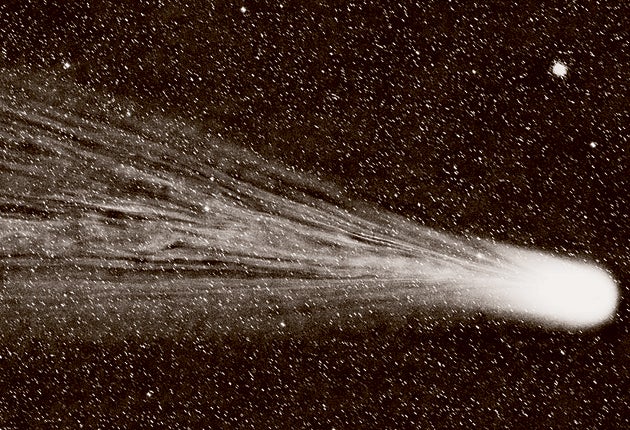Halley's Comet return: Keep your eyes peeled for a cosmic fireworks display later this month
Halley's Comet is coming back to the skies this month after almost 30 years

Your support helps us to tell the story
From reproductive rights to climate change to Big Tech, The Independent is on the ground when the story is developing. Whether it's investigating the financials of Elon Musk's pro-Trump PAC or producing our latest documentary, 'The A Word', which shines a light on the American women fighting for reproductive rights, we know how important it is to parse out the facts from the messaging.
At such a critical moment in US history, we need reporters on the ground. Your donation allows us to keep sending journalists to speak to both sides of the story.
The Independent is trusted by Americans across the entire political spectrum. And unlike many other quality news outlets, we choose not to lock Americans out of our reporting and analysis with paywalls. We believe quality journalism should be available to everyone, paid for by those who can afford it.
Your support makes all the difference.Halley’s Comet makes a return to our skies this month – but not quite in the form you’d expect.
If you want to see the real thing, you’ll have to hang on until 2061. And don’t hold your breath. Its appearance is predicted to be even more disappointing than that of 1985-86.
It’s actually the debris shed by Halley that we’ll encounter this October. Comets are dirty creatures; they leave a trail of cosmic dust behind themselves as they tramp around the Solar System. And on 21-22 October, Earth ploughs through remnants of Halley’s Comet as we orbit the Sun.
These particular meteors have their ‘‘radiant’’ in Orion (marked on the chart). Although you can trace an Orionid back to this point, it’s worth looking out for them all over the sky.
You don’t need any special equipment to observe a meteor shower. In the case of the Orionids, go out after midnight on 21-22 October (when the Earth will be turned towards the shower), lie down on a steamer – and wrap up warmly. At best, you should see up to 25 shooting stars per hour. These are fast-moving meteors, and they often leave a persistent train of light behind them as they are incinerated.
And talking of stunning images – next month, the Rosetta spacecraft will soft-land a probe on a comet. Currently in orbit around Comet Churyumov-Gerasimenko (better abbreviated to Comet C-G), Rosetta will place its Philae probe on the comet’s surface. Nothing so audacious has ever been attempted before, and the close-up photographs that Philae captures will transport us to a new world – literally.
What’s up
You may spot Mars low down in the south-west after sunset, but otherwise it’s all quiet on the bright planet front until 1am, when brilliant Jupiter rises in the north-east. During the last few days of October, early risers may catch the elusive planet Mercury low in the east before dawn. The innermost planet is putting on its best morning show of the year.
So it’s all eyes to the starry skies. If you’re in a dark place – maybe watching out for the Orionid meteors – take the chance to scan the Milky Way, arching high overhead. The gently glowing band of distant stars rises upwards from the constellation of Aquila (the Eagle) in the south, through the cross-shape of Cygnus (the Swan) and queen Cassiopeia almost overhead, before heading back downwards to the north-east, where it encompasses the hero Perseus and Auriga (the Charioteer), to end up in the celestial Bull (Taurus), with the Twins (Gemini) and the mighty hunter Orion.
And a couple of sky-sights for anyone who plans to be out of the country this month. On 8 October, there’s a total eclipse of the Moon that’s visible from countries all around the Pacific Ocean, including the United States and Canada on the east, and Australia, Indonesia, China and parts of Russia on the west. The western regions of Canada and the United States are also treated to a partial eclipse of the Sun on 23 October.
Diary
Full moon : 8 October 11.50am
Moon at last quarter : 15 October 8.12pm
Maximum of Orionid meteor shower : 21-22 October
New moon : 23 October 10.57pm
End of British Summer Time : 26 October 2.00am
Moon at first quarter : 31 October 2.48am
Join our commenting forum
Join thought-provoking conversations, follow other Independent readers and see their replies
Comments